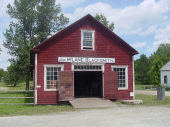|
 In the early days of the British North American colonies, ironwork, such as nails, had to be imported from England. This made ironwork so expensive that settlers would often burn down their homes so the nails could be reused in new homes.
In the early days of the British North American colonies, ironwork, such as nails, had to be imported from England. This made ironwork so expensive that settlers would often burn down their homes so the nails could be reused in new homes.
In the early days of the Jamestown settlement in the United States, Captain John Smith made desperate pleas to London for blacksmiths and other tradesmen. Soon after, smithing became a very lucrative business in the colonies. Blacksmiths were kept very busy making tools and other iron implements required for life in the New World.
A blacksmith's tools are very important to his trade. In the 1900s, larger tools, such as anvils, could be purchased, but smaller tools were made right in the blacksmith's own shop.
The anvil is key to the proper shaping of metal and must be smooth to ensure that metal wrought on its surface does not have any roughness. An anvil has two holes on the top: hardy and a punch. The hardy is square and is used for cutting metal and holding small tools. The punch is used for punching holes in metal. A small tool commonly used for rounding metal is called a mandrel.
In Sherbrooke Village, the forge, the hearth used for heating metal, is fired by coal. Our blacksmith heats the forge to 3,000° Fahrenheit, places a metal rod in the center of the fire and waits for the rod to get hot enough. When the rod is red hot, it is removed from the forge and taken to the anvil to be shaped. Once the desired shape is achieved, the finished piece is cooled in water, making it ready for use.
Visitors are welcome to watch the blacksmith at his work as he uses traditional tools to shape metal into nails, hooks, hot dog forks and other ironwork. Our blacksmith makes these and many other iron products which can be purchased by visitors at the Company Store.
Click for more pictures and movies

|

|

|
|